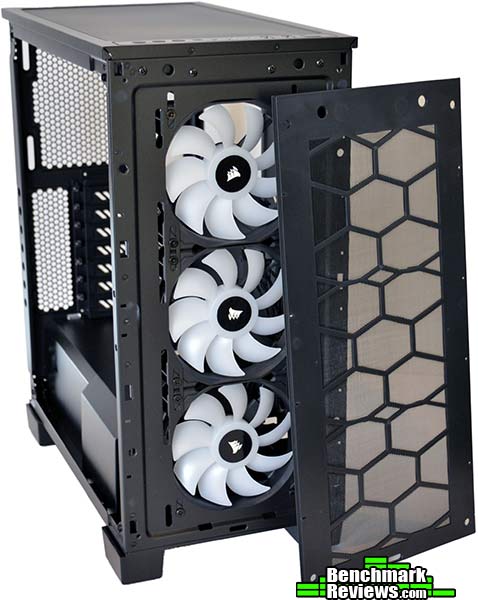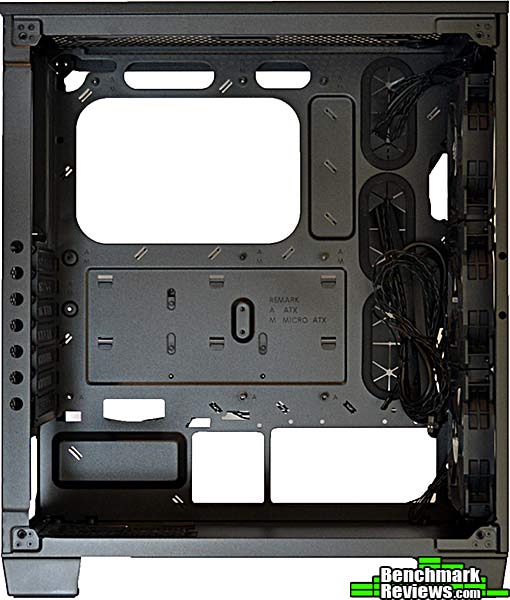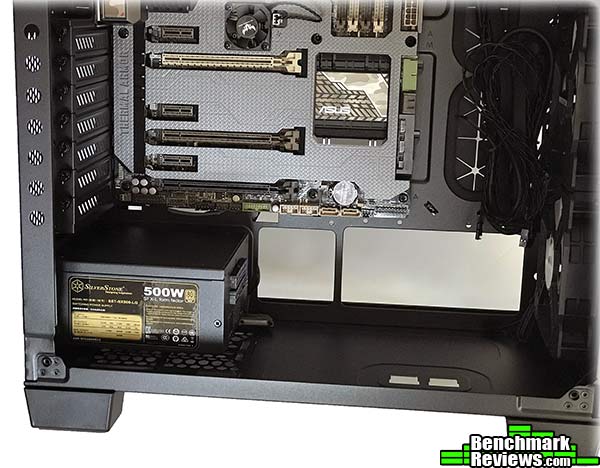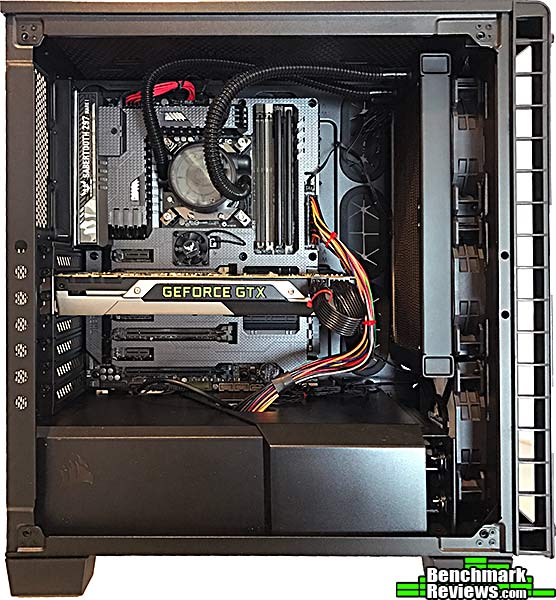By David Ramsey
Manufacturer: Corsair Components, Inc.
Product Name: Crystal Series 460X RGB Compact ATX Mid-Tower Case
Model Number: CC-9011101-WW
UPC: 843591093590
Price As Tested: $129.99 (Newegg | Amazon)Full Disclosure: Corsair Components Inc. provided the product sample used in this article.
If there are two big trends in computer accessories and peripherals these days, it’s “tempered glass” and “RGB illumination”. And if you can combine the two, as Corsair has done with the Crystal 460X RGB Compact ATX mid-tower case, so much the better! But there’s more to this case than just a serious amount of glam, and Benchmark Reviews will build a system in it to see if it would be a good home for your next gaming rig.

- Front and side tempered glass panels show off your hardware
- Room for two 3.5″ drives and three 2.5″ drives or SSDs
- 3x120mm SP120 RGB fans with integrated six-fan hub and lighting controller
- Dimensions (L x W x H): 440 x 220 x 464mm
- 7 slots
- Power supply and 3.5″ drive bay covers
Let’s take a look at this case in the next section…
Corsair calls the Crystal 460X RGB a “compact ATX” case. It is smaller than ATX cases you may have used in the past; it’s shorter front-to-back than older case designs because there are no drive bays in front, and it’s not quite as tall as there’s no room for a top-mounted radiator. You can, however, mount front 240mm or 360mm radiators (the latter would require removing the 3.5″ drive bays) as well as a 120mm radiator in the rear. This view is sans glass panels since the case is all but impossible to photograph with them on! Here you can see the plastic front spacer that holds the front glass panel about 1″ out from the case to allow air intake from the sides.

The front and side glass panels are a little tricky to remove and reinstall. Rather than hanging the panels on pegs and securing them with nuts, Corsair designed a system that uses very small “outcroppings” to hang the panel on…

…and secures them with these screws. The best way to remove or install the panels is to lay the case on its side or back so that the panel you want to remove is facing up. This minimizes the possibility that you’ll let a panel drop and shatter.

In this brave new world, there are no front drive bays. A removable cover hides two 3.5″ bays in front of the power supply. The three includes fans are Corsair’s SP120 RGB models. We reviewed the HD120 RGB fans here, and the difference seems to be that the SP120’s used in this case have their LEDs in the fan hub, whereas the HD120 have their LEDs at the rim. Confusingly, Corsair’s web page for the Crystal 460X RGB shows images of the case equipped with both types of fans.

The Crystal 460X RGB is “fully filtered”. The front filter is the most difficult to get to as you must remove four screws, pull off the tempered glass front panel, and then the plastic spacer panel behind that. The filter’s frame has imbedded magnets to keep it in place.

A slide-out power supply intake filter is on the bottom of the case…

A magnetically attached top filter rounds out the filter list…although I don’t understand its inclusion since top case fans are typically outward-facing, so the filter is extraneous.

At the top of the case we have three buttons for fan lighting control, a reset button, a hard disk activity indicator, headphone and microphone ports, two USB 3.0 connectors, and the power button.

Let’s look at more aspects of this case in the next section.
The back of the motherboard tray is festooned with tie down points and has rubber grommets covering the main cable management holes. In this image you can see the mounting bracket for three 2.5″ drives below the CPU cooler mounting plate cutout.
The three buttons for fan lighting control at the top of the case are extensions to the actual controller, which is here. Interestingly it’s labeled “SP Lighting Controller”, whereas the one I reviewed with the HD120 RGB fan kit was labeled “HD Lighting Controller”. The SP fans included with this case have four RGB LEDs mounted in the hubs, whereas the HD120 fans have 12 LEDs mounted around the rim of the fan. You can plug an HD120 fan into the SP hub, but it will default to white light, all the time, and ignore the controller options.

A six-fan lighting hub is included so you can add up to three more SP120 RGB fans. These connections are for lighting only: each fan has two cables, a lighting cable to plug into this hub and a 3-pin power cable.

2.5″ drives, presumably SSDs, easily snap into place in the three-drive bracket. The entire bracket is removable if you don’t need it. Not seen in this image are the clever “eject springs” that push the drive up and out of the bracket when you pull back the locking lever.

There are no surprises at the back of the case– it’s a standard bottom-power-supply ATX design with seven slots.

There’s exactly 5/8″ of clearance between the back of the motherboard tray and the side panel.

OK, it’s time to build a system in this case…
The only way to really evaluate a computer case is to build a system in it, so let’s get started. With the power supply shrouds and 3.5″ drive cage removed, the interior of the Corsair Crystal 460X RGB case is revealed to be a standard mid-tower design. One nice touch is that all the motherboard standoffs are built into the case, so you don’t have to screw them in yourself.

There’s plenty of room for even large power supplies, but all I had on hand was this SFX-L unit, which looks tiny…

Installing a 240mm AIO water cooler means you have to remove the two top fans, attach them to the radiator, and then attach the whole assembly back to the front of the case. A 360mm radiator would fit but you’d have to remove the 3.5″ drive bays.

Remember how I measured 5/8″ cable clearance for the back of the motherboard tray? That does not include the area behind the three 2.5″ drive brackets, which present a problem: they touch the rear case panel when it’s on, so you can’t run any cables over the bracket. This makes connecting SATA power connectors, which are almost always attached at right angles to their cables, difficult. This one issue almost negates the utility of these drive bays. It might be possible to bend the cable very sharply, right at the connector, to force it to fit, but I elected to simply install my SSD in one of the 3.5″ drive bays. Corsair could have addressed this issue by either engineering a bulge into the case side panel over these brackets, or by supplying a custom 3-position SATA power extension cable.

Corsair provides a plethora of tie down points on the back of the motherboard tray, so keeping your cables reasonably tidy is pretty easy, as long as you avoid the 2.5″ drive bracket area.

And we’re done! A full ATX system with a 240mm water cooler all fits easily and well. Sadly the SFX main power cable was too short to route neatly behind the motherboard.

I’ll present my final thoughts and conclusion in the next section.
Corsair’s Crystal 460X RGB case leverages tempered glass side panels and adjustable RGB fans to spice up what would otherwise be just another mid-tower case. Corsair uses the modern conceit of “no front drive bays” and “ESPECIALLY no 5.25″ bay” to make this one of the smallest ATX cases I’ve ever seen, only slightly larger than some of the porkier mITX cases on the market! The case is small enough to sit on top of your desk without overwhelming it.
Functionality is great, but this case is really about visual appeal, and its lightly smoked glass panels and RGB fans give it an elegant look. With a few other lighting editions– a rear ring light fan, a Cooler Master Master Liquid Pro 240 cooler, and a lit-logo GTX770– I was able to create a very nice setup.

That said, I do have a few nitpicks. The most serious issue is 2.5″ drive bracket design. The bracket itself is great, with snap-in drive mounting aided with a spring-loaded ejectors. But since there is no clearance at all between the bracket and the case side panel, the bracket is almost unusable, since it’s difficult-to-impossible to route standard SATA power cables in a way that they don’t go over the bracket. A side panel with a bulge over the bracket would be one solution, although a special SATA power extension cable would work too.
The glass panels themselves are a little fiddly to get off and one, since the case has only vestigial pegs to hang them from. The solution here is to tip the case on its back or side so that the glass panel you’re dealing with is facing up.
Last, there are the fans. The SP120RGB fans are the poor cousins of the HD120RGB fans I reviewed recently. Their four hub-mounted LEDs can’t hold a candle, literally, to the 12 rim-mounted LEDs of the HD120RGB fans; there are fewer lighting effects, and most annoyingly the fans use three-pin connectors, which means your motherboard and water cooling system probably won’t be able to control their RPM. I’d love to see Corsair offer a version of this case with the HD120RGB fans. You could of course simply buy this case, a three-pack of HD120RGB fans, and do it yourself, but that’s another $85.00 you’ll have to spend. Corsair does not offer a version of this case without the SP120RGB fans but with the integrated fan light controller.
The Corsair Crystal 460X RGB is a stylish and compact full ATX case that leverages its use of tempered glass panels and RGB fans to provide a relatively inexpensive, yet striking, home for your system. Three front 120mm fans will provide plenty of quiet airflow, even without rear or top fans to exhaust the case, and the integrated lighting controller on the top of the case lets you set everything from “lights off” to a dim, steady color to a near-disco flashing display.
The Crystal 460X RGB is easy to build in, although the rear-mounted 2.5″ drive bays proved problematic. I think Corsair should at least provide a custom SATA power extension cable for these bays, as they are very difficult to use otherwise due to cable clearance issues.
I’d like to see a version of this case with the brighter and more versatile HD120 RGB fans, but the SP120 RGB’s still work well in this application.
With the typical Corsair attention to quality and design, this case makes an impressive showing at its street price of $129.99 (Newegg | Amazon), and is definitely worth a look.
+ Compact size for a full ATX case
+ Front and side glass panels
+ Included RGB fans with integrated fan lighting controller
+ Fully filtered airflow
+ Good cable management (except for 2.5″ bracket issues)
– Utility of 2.5″ drive brackets compromised by cable clearance issues
– Must be careful removing and replacing glass panels
– SP120 RGB fans not as bright as HD120s, lack four-pin cable for PWM control
-
Performance: 9.00
-
Appearance: 9.25
-
Construction: 9.25
-
Functionality: 8.25
-
Value: 9.00



2 thoughts on “Corsair Crystal 460X RGB Compact ATX Case Review”
Clearly not designed with water cooling in mind, this case is great for those who are after a well designed, good looking case to build an average system in, with RGB to dress it up.
Not one to argue with a reviewer, but why insist on fitting an A.I.O with a 240mm radiator in to the front of a case which in my opinion only increases heat going in to the case!
The clear choice should be a smaller 120mm radiator placed at the rear exhausting the heat.
Ideally the case should have been made with extra height to allow a top mount radiator without resorting to some ridiculous external radiator mounting modification on the top.
The point of the AIO system isn’t to remove heat from the case; it’s to remove heat from the processor. While a direct air flow out of the case with a top-mounted rad would be superior in theory, in practice it doesn’t really make a difference: even under heavy CPU loads, the air coming off the radiator is only somewhat warm; the minor increase in temperature isn’t enough to affect the operation of anything inside the case.
That said, the 240mm setup was overkill for this build, but it’s what I had laying around.
Comments are closed.